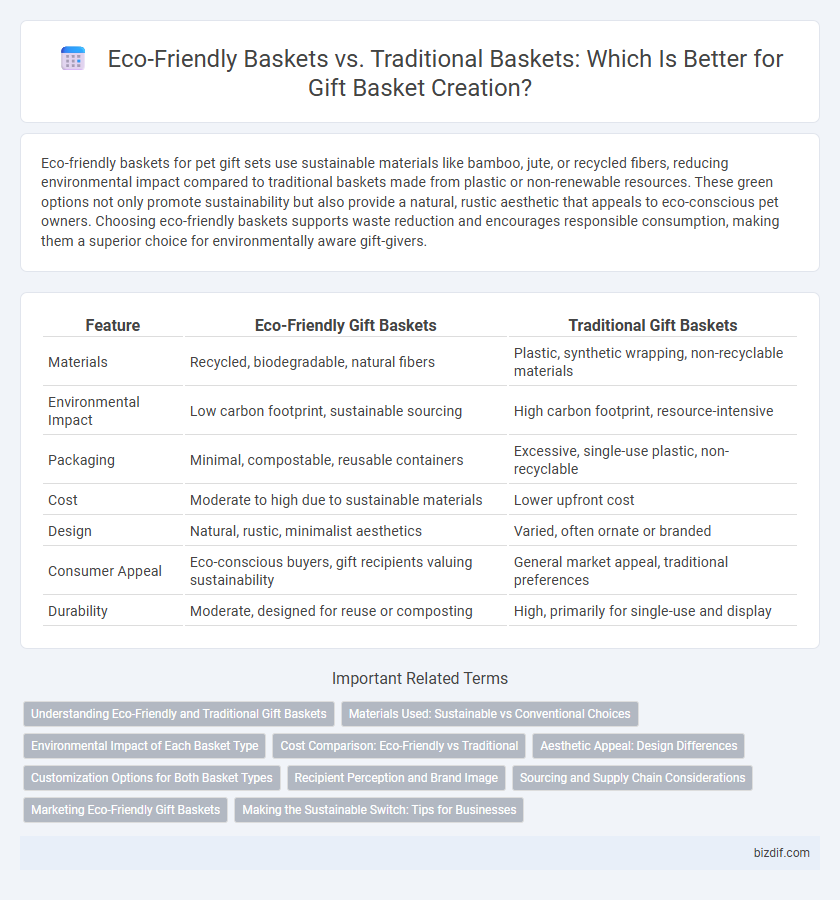Eco-friendly baskets for pet gift sets use sustainable materials like bamboo, jute, or recycled fibers, reducing environmental impact compared to traditional baskets made from plastic or non-renewable resources. These green options not only promote sustainability but also provide a natural, rustic aesthetic that appeals to eco-conscious pet owners. Choosing eco-friendly baskets supports waste reduction and encourages responsible consumption, making them a superior choice for environmentally aware gift-givers.
Table of Comparison
| Feature | Eco-Friendly Gift Baskets | Traditional Gift Baskets |
|---|---|---|
| Materials | Recycled, biodegradable, natural fibers | Plastic, synthetic wrapping, non-recyclable materials |
| Environmental Impact | Low carbon footprint, sustainable sourcing | High carbon footprint, resource-intensive |
| Packaging | Minimal, compostable, reusable containers | Excessive, single-use plastic, non-recyclable |
| Cost | Moderate to high due to sustainable materials | Lower upfront cost |
| Design | Natural, rustic, minimalist aesthetics | Varied, often ornate or branded |
| Consumer Appeal | Eco-conscious buyers, gift recipients valuing sustainability | General market appeal, traditional preferences |
| Durability | Moderate, designed for reuse or composting | High, primarily for single-use and display |
Understanding Eco-Friendly and Traditional Gift Baskets
Eco-friendly gift baskets are crafted using sustainable materials such as recycled paper, bamboo, and organic fabrics, minimizing environmental impact compared to traditional baskets that often use plastic or non-renewable resources. These eco-conscious baskets prioritize biodegradability and recyclable components, aligning with growing consumer demand for environmentally responsible gifting options. Traditional gift baskets typically emphasize decorative appeal and variety but may contribute to waste due to non-eco-friendly packaging and synthetic fillers.
Materials Used: Sustainable vs Conventional Choices
Eco-friendly gift baskets prioritize materials like bamboo, recycled paper, and organic cotton, reducing environmental impact through renewable and biodegradable resources. Traditional baskets often use conventional materials such as plastic, synthetic fibers, and untreated wood, contributing to higher carbon footprints and waste. Sustainable choices not only support eco-conscious consumers but also enhance the basket's durability and aesthetic appeal with natural textures and finishes.
Environmental Impact of Each Basket Type
Eco-friendly gift baskets use sustainable materials such as recycled paper, organic fibers, and biodegradable packaging, significantly reducing landfill waste and carbon footprint compared to traditional baskets made from plastic or non-renewable resources. The production of eco-friendly baskets often involves lower energy consumption and emits fewer greenhouse gases, promoting a healthier ecosystem. Traditional baskets typically contribute to pollution and resource depletion due to synthetic materials and non-recyclable components, intensifying environmental degradation.
Cost Comparison: Eco-Friendly vs Traditional
Eco-friendly gift baskets often have higher upfront costs due to sustainable materials like bamboo, recycled paper, and organic fabrics, whereas traditional baskets typically use cheaper materials such as plastic and synthetic fibers. Over time, eco-friendly baskets provide better value by reducing environmental impact and often benefiting from durability, leading to fewer replacements. Consumers prioritizing sustainability may find the slightly higher initial investment justified compared to the lower initial cost of traditional baskets.
Aesthetic Appeal: Design Differences
Eco-friendly gift baskets often feature natural materials such as bamboo, jute, or recycled paper, creating a rustic and organic aesthetic that appeals to environmentally conscious consumers. Traditional baskets typically use classic wicker or plastic, resulting in a polished and uniform look favored in conventional gifting. The design differences emphasize sustainable textures and earthy colors in eco-friendly options, contrasting with the more vibrant or glossy finishes found in traditional baskets.
Customization Options for Both Basket Types
Eco-friendly gift baskets often feature biodegradable materials and allow customization with organic or sustainably sourced products, appealing to environmentally conscious consumers. Traditional baskets offer a wider variety of shapes, sizes, and materials such as wicker or plastic, providing flexibility in design and durability. Both basket types support personalized arrangements, but eco-friendly options increasingly include customizable reusable packaging and natural fillers to enhance sustainability without sacrificing aesthetic appeal.
Recipient Perception and Brand Image
Eco-friendly gift baskets often enhance recipient perception by conveying environmental responsibility and modern values, creating a memorable unboxing experience. Brands using sustainable materials for their baskets strengthen their image as socially conscious and forward-thinking, appealing to eco-aware consumers. In contrast, traditional baskets may be perceived as less innovative, potentially diminishing perceived brand commitment to sustainability and limiting appeal to a growing market segment focused on green practices.
Sourcing and Supply Chain Considerations
Eco-friendly gift baskets prioritize sustainable sourcing by using materials like recycled fibers, organic fabrics, and biodegradable packaging, reducing environmental impact throughout the supply chain. Traditional baskets often rely on non-renewable or synthetic materials sourced through less transparent supply chains, which can contribute to higher carbon footprints and waste. Choosing eco-friendly baskets supports ethical production practices, traceable sourcing, and lower emissions during transportation and manufacturing stages.
Marketing Eco-Friendly Gift Baskets
Eco-friendly gift baskets offer sustainable options by using biodegradable materials like recycled paper, organic fabric, and natural fibers, appealing to environmentally conscious consumers. Marketing eco-friendly baskets highlights the environmental benefits, such as reduced carbon footprint and waste, which resonates with green-minded customers seeking responsible gift choices. Emphasizing certifications, such as FSC-certified wood and compostable packaging, enhances credibility and attracts a growing market segment invested in sustainability.
Making the Sustainable Switch: Tips for Businesses
Switching to eco-friendly gift baskets reduces environmental impact by using biodegradable materials like bamboo, recycled paper, and organic fabrics, enhancing brand sustainability. Businesses can attract eco-conscious customers by sourcing local, seasonal products and minimizing plastic packaging, which lowers carbon footprints and waste. Implementing these practices not only supports green initiatives but also strengthens brand reputation in competitive markets focused on sustainability.
Eco-friendly baskets vs traditional baskets Infographic

 bizdif.com
bizdif.com